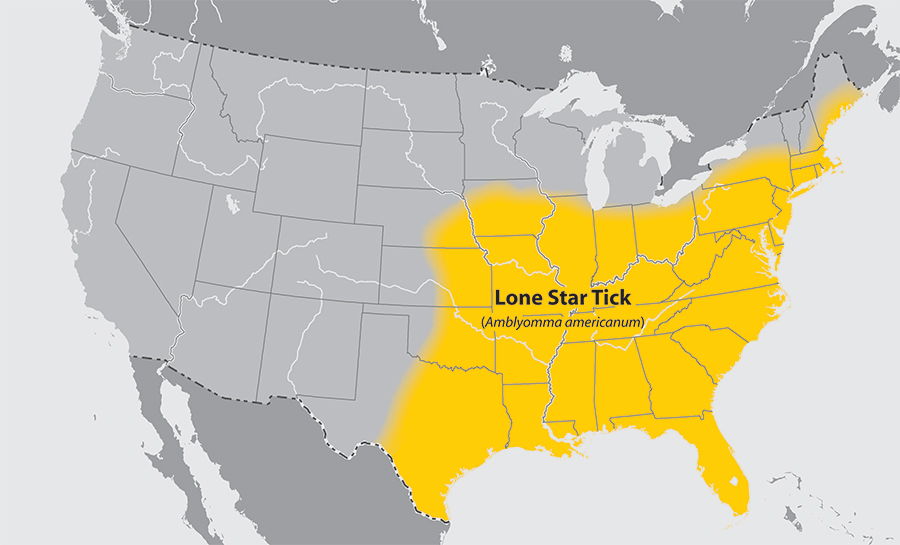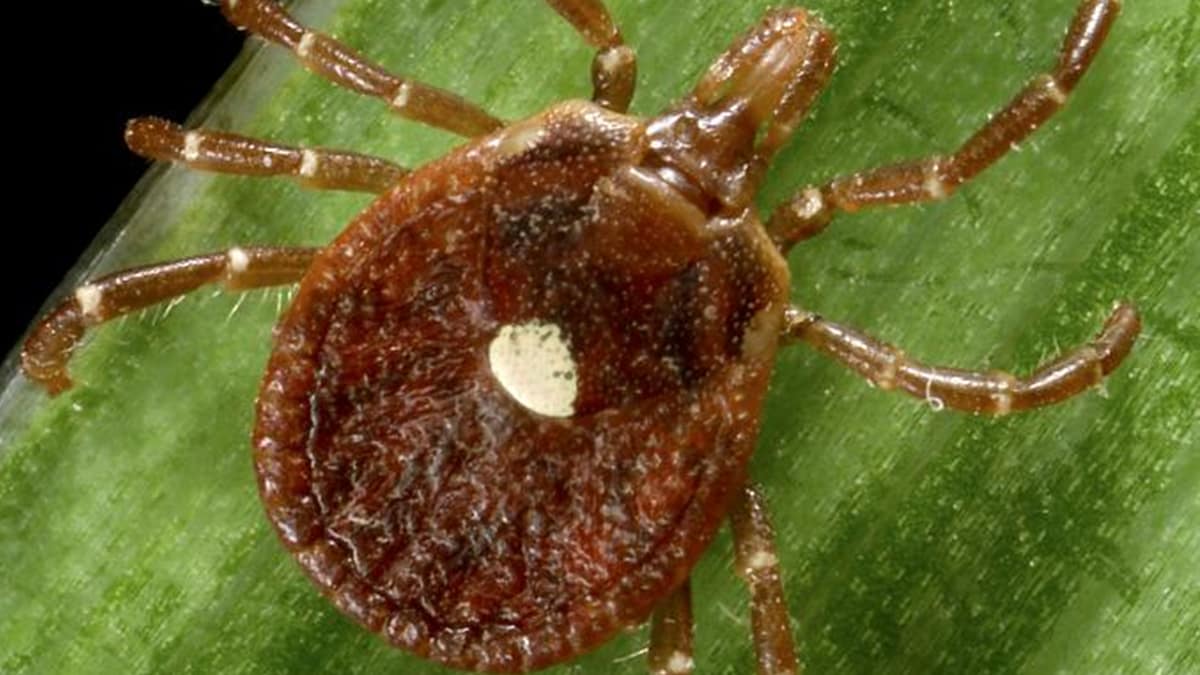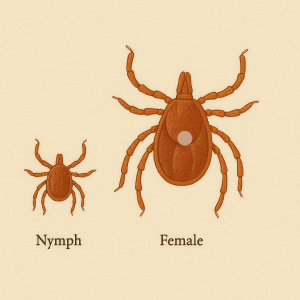Description & Other Names
The Lone Star tick gets its name from the distinctive white dot on the back of the adult female. It looks like a lone star⭐️. It’s a medium-sized tick. Females are brownish-orange with that single white spot. Males are smaller and have some subtle reddish-brown mottling but no clear dot. Nymphs are small (like a pinhead) and larvae are tiny (nearly invisible specks). Lone Star ticks are very aggressive biters. Unlike deer ticks which are a bit passive, Lone Stars will actively move towards you. They can crawl pretty fast (for a tick) and often in numbers. Sometimes people will report encountering a “seed tick” invasion. Those are Lone Star tick larvae or nymphs, which can be dozens at a time. So if you find multiple tiny ticks attached, that’s often Lone Star tick babies.
Where Found
Lone Star ticks are found widely across the Eastern, Southeastern, and South-Central U.S.. Think of a big swath from Texas up to Iowa/Illinois, and eastward to the Atlantic (through the Carolinas and into parts of the Mid-Atlantic). The heart of Lone Star tick territory is the Southeast (Oklahoma, Arkansas, Missouri, Kansas, Kentucky, Tennessee, Georgia, the Carolinas, Virginia). But they are also in the Northeast in increasing numbers (they’ve expanded into Maryland, Delaware, New Jersey, even Long Island NY in recent years). Basically the entire eastern half of the U.S. has Lone Stars, more in the south but moving north.

Habitat: they like wooded areas and especially brushy, thick undergrowth. They’re common in second-growth forests, along animal trails. They also often inhabit areas with lots of wildlife: deer, turkeys (turkeys carry a lot of Lone Star ticks), etc. If you go hunting or hiking in thick brush in Georgia or Missouri, you’ll likely encounter Lone Star ticks.
Diseases Spread
Lone Star ticks are associated with several illnesses:
- Ehrlichiosis
Ehrlichia chaffeensis and E. ewingii are transmitted by Lone Star ticks.
This tick is the major vector for Human Monocytic Ehrlichiosis (HME) in the U.S. - Tularemia
They can transmit Francisella tularensis (tularemia) as well, though dog ticks can also do that. - Heartland virus
Lone Star ticks are believed to transmit Heartland virus, which has caused illness in a few dozen people in the Midwest/South. - STARI
Lone Star tick bites are linked to Southern Tick-Associated Rash Illness (STARI), which causes a Lyme-like rash and mild illness. The exact cause isn’t confirmed, but it’s believed to be a bacterium carried by Lone Stars. - Bourbon virus
Evidence suggests Lone Star ticks may transmit Bourbon virus disease (only a couple cases known, but still). - Alpha-gal syndrome
The Lone Star tick is infamous for causing a red meat allergy in some people. It’s not an infectious disease, but rather the tick’s saliva can trigger an immune response to a carbohydrate (alpha-gal) that is present in red meat, leading to allergic reactions hours after eating meat. If you suddenly can’t tolerate bacon then a Lone Star tick might be to blame!
So in summary, Lone Star ticks can give you ehrlichiosis, and have been linked to a variety of viruses and unusual conditions. One thing they do NOT transmit is Lyme disease; Borrelia burgdorferi isn’t carried by Lone Stars (though there’s some evidence they might rarely carry a related Borrelia causing STARI, but not the main Lyme germ). If someone finds a Lone Star tick attached, we worry about ehrlichiosis and maybe tularemia, but we generally don’t worry about Lyme from that particular bite.
Active Season
Lone Star ticks are most active in late spring and summer. Nymphs and larvae tend to be out in summer (July/August, often in huge numbers). Adults are often active from April through August, with a peak in mid-spring to early summer. In warmer climates (like the Deep South), they can have a pretty long active season (spring through fall). They don’t tolerate the very cold northern winters as well, which naturally limited them, but as it warms they’ve crept north. These ticks are fierce. Hikers in Missouri or Virginia often will end a day with many Lone Stars on their clothing if not properly protected. Always do tick checks after being in Lone Star tick country, because they often come in bunches.
How to Identify
The female Lone Star tick’s white dot is a giveaway. No other tick has that. Males don’t have the clear spot but have some white streaks on the margins of their back. Lone Stars are a bit larger than deer ticks (closer to dog tick size, but without the ornate patterns of a dog tick). They are kind of reddish-brown. If you see a medium-sized brown tick with long mouthparts and, on the female, a single white spot, that’s a Lone Star. Their body shape is a bit rounder than a dog tick’s which is more oval. After feeding, Lone Stars can get quite large and grayish (like a big grape). Often, identification is by geography and behavior too. If you got swarmed by tiny seed ticks in say, Alabama, those are Lone Star tick larvae (deer tick larvae don’t typically swarm humans). Lone Stars also tend to cause more skin irritation at the bite site; people often notice a red bump or itchiness where a Lone Star tick bit (their saliva is irritating), whereas deer tick bites are usually painless. So an itchy tick bite might hint it was a Lone Star (though that’s not 100% reliable).


